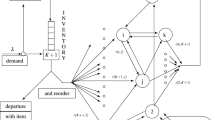Abstract
We address the optimal allocation of a given capacity in a multi-product inventory–production system with base stock. In the system, the base stock level is equal to the sum of the finished goods and work-in-process inventory. Each exogenous demand releases production of a new unit and increases the level of work-in-process. Unsatisfied demand is backordered. Using an open single-server queueing network, we model the behavior of the work-in-process in the manufacturing system in order to determine the cost-optimal base stock level. We focus on the utilizations in the network and compare balanced and unbalanced systems regarding their base stock level. In particular, we analyze the effect of capacity reallocation and show that a manufacturing system consisting of production stations with constant utilization rates, results in the lowest base stock level. With the combined application of queueing network theory and majorization theory, we are able to provide analytical explanations of the network’s behavior.



Similar content being viewed by others
References
Arumugam, R., Mayorga, M. E., & Taaffe, K. M. (2009). Inventory based allocation policies for flexible servers in serial systems. Annals of Operations Research, 172(1), 1–23.
Bitran, G. R., & Tirupati, D. (1989). Capacity planning in manufacturing networks with discrete options. Annals of Operations Research, 17(1), 119–135.
Bradley, J. R., & Glynn, P. W. (2002). Managing capacity and inventory jointly in manufacturing systems. Management Science, 48(2), 273–288.
Buyukkaramikli, N. C., Bertrand, J. W. M., & van Ooijen, H. P. (2013). Flexible hiring in a make to order system with parallel processing units. Annals of Operations Research, 209(1), 159–178.
Buyukkaramikli, N. C., van Ooijen, H. P., & Bertrand, J. W. M. (2015). Integrating inventory control and capacity management at a maintenance service provider. Annals of Operations Research, 231(1), 185–206.
Buzen, J. P. (1973). Computational algorithms for closed queueing networks with exponential servers. Communications of the ACM, 16(9), 527–531.
Chao, X., Miyazawa, M., & Pinedo, M. (1999). Queueing networks: Customers, signals and product form solutions. Chichester: Wiley.
Chen, H., & Yao, D. D. (2001). Fundamentals of queueing networks: Performance, asymptotics, and optimization (Vol. 46). Berlin: Springer.
de la Cruz, N. N., & Daduna, H. (2016). Monotonicity of base stock policies. Operations Research Letters, 44(2), 186–190.
Dharmadhikari, S., & Joag-Dev, K. (1988). Unimodality, convexity, and applications. Amsterdam: Elsevier.
Duri, C., Frein, Y., & Di Mascolo, M. (2000). Comparison among three pull control policies: Kanban, base stock, and generalized kanban. Annals of Operations Research, 93(1), 41–69.
Krishnamoorthy, A., Lakshmy, B., & Manikandan, R. (2011). A survey on inventory models with positive service time. Opsearch, 48(2), 153–169.
Marshall, A. W., Olkin, I., & Arnold, B. C. (1979). Inequalities: Theory of majorization and its applications (Vol. 143). Berlin: Springer.
Mayorga, M. E., Taaffe, K. M., & Arumugam, R. (2009). Allocating flexible servers in serial systems with switching costs. Annals of Operations Research, 172(1), 231–242.
Osorio, C., & Bierlaire, M. (2009). An analytic finite capacity queueing network model capturing the propagation of congestion and blocking. European Journal of Operational Research, 196(3), 996–1007.
Reed, J., & Zhang, B. (2017). Managing capacity and inventory jointly for multi-server make-to-stock queues. Queueing Systems, 86(1–2), 61–94.
Rubio, R., & Wein, L. M. (1996). Setting base stock levels using product-form queueing networks. Management Science, 42(2), 259–268.
Shaked, M., & Shanthikumar, J. G. (1994). Stochastic orders and their applications., Probability and mathematical statistics Boston: Academic Press.
Spearman, M. L., & Zazanis, M. A. (1992). Push and pull production systems: Issues and comparisons. Operations Research, 40(3), 521–532.
Stecke, K. E., & Morin, T. L. (1985). The optimality of balancing workloads in certain types of flexible manufacturing systems. European Journal of Operational Research, 20(1), 68–82.
Stecke, K. E., & Solberg, J. J. (1985). The optimality of unbalancing both workloads and machine group sizes in closed queueing networks of multiserver queues. Operations Research, 33(4), 882–910.
Toktay, L. B., Wein, L. M., & Zenios, S. A. (2000). Inventory management of remanufacturable products. Management Science, 46(11), 1412–1426.
Zazanis, M. A. (1994) Push and pull systems with external demands. In Proceedings of 32nd Allerton conference on communication, control and computing, Allerton, IL (pp 691–698).
Acknowledgements
We would like to thank the reviewers for their helpful suggestions and remarks.
Author information
Authors and Affiliations
Corresponding author
Ethics declarations
Conflict of interest
The authors declare that they have no conflict of interest.
Proof of Proposition 1
Proof of Proposition 1
In the proof, we use
Lemma 1
For \(j \in \overline{J}\) the jth partial derivative (of order 1) is
Proof of Proposition 1
From the definition of \(G(n,\overline{J})(\rho _1,...,\rho _J)\), the functions \(\phi ^{(z)}\) are symmetric on \(A=(0,1)^J\). Thus, we have to show
Using Lemma 1, we firstly calculate the numerator of the fraction. (For shorthand notation we abbreviate \(G(n,\overline{J})(\rho _1,...,\rho _J) =G(n,\overline{J})\) whenever the argument \((\rho _1,...,\rho _J)\) is obvious.)
Consequently, we have
Since we started from an ergodic Jackson network, we have \(\rho _i \in (0,1)\), \(\forall i \in \overline{J}\). So \(\phi ^{(z)}\) is Schur-concave if
For the right side of the inequality, we have
With the last equation, we can complete our proof with
Thus, \(\phi ^{(z)}\) is Schur-concave on A. \(\square \)
Rights and permissions
About this article
Cite this article
de la Cruz, NN., Daduna, H. Optimal capacity allocation in a production–inventory system with base stock. Ann Oper Res 277, 329–344 (2019). https://doi.org/10.1007/s10479-017-2687-9
Published:
Issue Date:
DOI: https://doi.org/10.1007/s10479-017-2687-9




